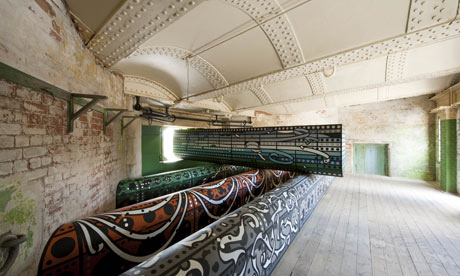
'If you want to disappear or become anonymous, go to Jaywick." Tim and his wife Helen laugh – but they're not joking. After all, they own a couple of properties in the notoriously run-down Essex resort. "It's been forgotten about," sighs Tim, a former hotelier. "The roads are better in a Rio shanty town." We are having this conversation, somewhat incongruously, while sunning ourselves on the terrace of The Pier, an upmarket hotel in Harwich. I'm here for Fleet: Art in the Haven Ports, a summer-long programme bringing art to unusual locations along the Essex and Suffolk coast. And although Jaywick is my final stop, it's all everyone seems to be talking about.
But first, Harwich. Like any good English seaside town, it's a forlorn but fascinating mix of eclectic architecture, well-hidden galleries and second-hand bookshops. I wander the streets towards the Electric Palace, one of the UK's oldest purpose-built (1911) cinemas to survive with screen, original projection room and frontage intact. It's also set to host screenings by film-makers during Fleet. "Since 1981 it's been running as a charity," explains volunteer Christine Woodman, who pokes her head through the curtain (a film's under way) and talks me through its history and freshly painted facade.
Although it's not quite a resort, the town's maritime connections with the continent mean a steady drip of visitors along its L-shaped Ha'penny Pier (so called because of the halfpenny toll charged when it opened in 1853), and esplanade, where pensioners sit three to a bench. The Pier hotel – built in 1852 to resemble a Venetian palazzo – is pivotal for the tourist trade, and a romantic spot: as I devour local scallops in the first-floor restaurant, I also gulp down the view of a cruise ship gliding along the Stour Estuary. "I never tire of watching the ships," says the manager.
But there is art to be sampled, and I board the early morning foot ferry for the 15-minute trip to Felixstowe. A cool breeze blows over the grey-green water as we pass the Navyard wharf, and the longest docks in Europe. Dismounting on the steep shingle beach, I spot the body of a deer washed up on the pebbles, its face disturbingly serene. Sadly, it's not an art installation.
Dominating the Orwell estuary, the Landguard Fort, which dates back to the time of Henry VIII, plays host to four artists. Until 16 July, it houses Gavin Turk's Les bikes du bois rond, a 21-strong fleet of "art bikes" inspired by 1970s artist André Cadere. Turk has underlined his work's portable nature by two "art bike" rides, the second of which takes place next weekend (17 July) and is open to the public. For the rest of the summer (22 July until 28 August, Thursday to Saturday, 11am-4pm) visitors can see the bikes at St Mary's Church, Ipswich. An exhibition curated by Turk from Calais's FRAC Collection is on at Town Hall galleries in Ipswich. Also there, though unrelated, the Ipswich Art School is launching a new art space next weekend, opening with an exhibition from the Saatchi Gallery that runs until January.
Three other artists are showing at the Landguard (until 30 July). Tod Hanson's large-scale graphic work Juggernaut Sunset examines the nature of defensive spaces; Elizabeth Wright's Shoot positions 24 speed-camera signs throughout the fort, playing with the meanings of being "captured", and the visitor's experience of a former site of combat; and, most striking of all, east Londoner Cedric Christie's Dance 2010 – two vast twisted forms relax on the scorched grass in the courtyard, each built from four aluminium maypole-coloured ribbons, juxtaposing the rituals and banalities of "Merry England" with the foreboding walls of the keep.
You'd be hard pushed, however, to uncover much combat in the wealthy village of Mistley. Its neo-classical Mistley Towers, overlooking a broad sweep of the Stour, were designed in 1776 as part of a church by Robert Adam. Until 31 July they play host to Augury (Migration) by artist Julian Meredith, whose monoprints, wood-cuts and printed textiles explore the relationship of fish and birds to their environment and to us. But I'm distracted by reading about 17th-century local boy Matthew Hopkins, Witchfinder General, who operated from the Mistley Thorn inn, now an airy restaurant-with-rooms.
Mistley's pastel cottages and craft workshops unfurl their delights far more readily than my final destination, Jaywick. Jaywick's Martello Tower was built in 1809 (and restored in 2005 as an arts venue) and will from 14-25 July be home to artist-in-residence Sarah Dobai, who is showing a three-screen video work exploring the influence of a place and its history on its residents.
And what a history! It was planned as a cheap holiday retreat for Londoners in the 1930s, and many of Jaywick's original timber-built chalet houses, poorly constructed on the edge of its golden sands, have become permanent residences. I stroll down the narrow, potholed lanes of the Brooklands area, whose flood-land status prohibits further planning. As Tim and Helen warned back in Harwich, I'm indeed reminded of a Brazilian favela: radios blast from broken windows, whippet-thin young men slouch on outdoor furniture drinking beer, and the elderly watch from wooden verandas. Every other house is boarded up, or overgrown by poppies. But still there's a unique spirit; an air of defiance, self-reliance.
"We have commissioned works from well-known contemporary artists, who will bring a new understanding to these historic places," says David Wright, director of Commissions East, in the blurb. It's an admirable statement, though the locations defy such easy understanding. But Fleet is a welcome attempt to draw visitors to a part of Essex that is criminally overlooked.
• Further information: visitessex.com or fleet-art.org. The Pier hotel and restaurant (01255 241212, milsom hotels.com/thepier), doubles from £130 in high season. Travel in the region on National Express East Anglia

